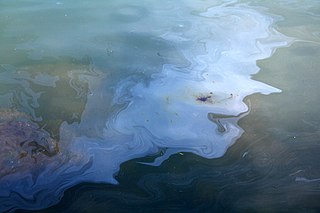
Pseudomonas is a genus of Gram-negative, Gammaproteobacteria, belonging to the family Pseudomonadaceae and containing 191 validly described species. The members of the genus demonstrate a great deal of metabolic diversity and consequently are able to colonize a wide range of niches. Their ease of culture in vitro and availability of an increasing number of Pseudomonas strain genome sequences has made the genus an excellent focus for scientific research; the best studied species include P. aeruginosa in its role as an opportunistic human pathogen, the plant pathogen P. syringae, the soil bacterium P. putida, and the plant growth-promoting P. fluorescens, P. lini, P. migulae, and P. graminis.

Bacillus mycoides is a bacterium of the genus Bacillus. Like other Bacillus species, B. mycoides is Gram positive, rod-shaped, and forms spores. B. mycoides is distinguished from other Bacillus species by its unusual growth on agar plates, where it forms expansive hairy colonies with characteristic swirls.
In biology, syntrophy, synthrophy, or cross-feeding is the phenomenon of one species living off the metabolic products of another species. In this type of biological interaction, the growth of one partner depends on the nutrients, growth factors, or substrates provided by the other partner. Jan Dolfing describes syntrophy as "the critical interdependency between producer and consumer". This term for nutritional interdependence is often used in microbiology to describe this symbiotic relationship between bacterial species. Morris et al. have described the process as "obligately mutualistic metabolism".
Dehalococcoides is a genus of bacteria within class Dehalococcoidia that obtain energy via the oxidation of hydrogen and subsequent reductive dehalogenation of halogenated organic compounds in a mode of anaerobic respiration called organohalide respiration. They are well known for their great potential to remediate halogenated ethenes and aromatics. They are the only bacteria known to transform highly chlorinated dioxins, PCBs. In addition, they are the only known bacteria to transform tetrachloroethene to ethene.
Desulfatibacillum alkenivorans AK-01 is a specific strain of Desulfatibacillum alkenivorans.

The class Gammaproteobacteria belongs to the Proteobacteria phylum and contains about 250 genera, which makes it the most genera-rich taxon of the Prokaryotes. Several medically, ecologically, and scientifically important groups of bacteria belong to this class. It is composed by all Gram-negative microbes and is the most phylogenetically and physiologically diverse class of Proteobacteria.

Alcanivorax is a genus of alkane-degrading marine bacteria.
Alcanivorax borkumensis is an alkane-degrading marine bacterium which naturally propagates and becomes predominant in crude-oil-containing seawater when nitrogen and phosphorus nutrients are supplemented.
Variovorax paradoxus is a gram negative, beta proteobacterium from the genus Variovorax. Strains of V. paradoxus can be categorized into two groups, hydrogen oxidizers and heterotrophic strains, both of which are aerobic. The genus name Vario-vorax and species name para-doxus (contrary-opinion) reflects both the dichotomy of V. paradoxus metabolisms, but also its ability to utilize a wide array of organic compounds.
Acinetobacter venetianus is a species of bacteria notable for degrading n-alkanes. It harbours plasmids carrying sequences similar to the Pseudomonas oleovorans alkane hydroxylase gene alkBFGH. Its potential for bioremediation is an active research topic, particularly its role in the production of the bioemulsifier emulsan. Its type strain is RAG-1T(=ATCC 31012T=CCUG 45561T=LMG 19082T=LUH 3904T=NIPH 1925T).
Alcanivorax pacificus is a pyrene-degrading marine gammaprotobacterium. It is of the genus Alcanivorax, a group of marine bacteria known for degrading hydrocarbons. When originally proposed, the genus Alcanivorax comprised six distinguishable species. However, A. pacificus, a seventh strain, was isolated from deep sea sediments in the West Pacific Ocean by Shanghai Majorbio Bio-pharm Technology Co., Ltd. in 2011. A. pacificus’s ability to degrade hydrocarbons can be employed for cleaning up oil-contaminated oceans through bioremediation. The genomic differences present in this strain of Alcanivorax that distinguish it from the original consortium are important to understand to better utilize this bacteria for bioremediation.
Ruegeria pomeroyi is a species of Gram-negative, rod-shaped, aerobic dimethylsulfoniopropionate-demethylating bacterium. Its type strain is DSS-3T. Its genome has been sequenced.
Shewanella decolorationis is a gram-negative, dye-decolorizing bacterium first isolated from activated sludge of a waste-water treatment plant. It is motile by means of a single polar flagellum. The type strain is S12T. Its genome has been sequenced.
Clostridium straminisolvens is a moderately thermophilic, aerotolerant and cellulolytic bacterium. It is non-motile, spore-forming, straight or slightly curved rod, with type strain CSK1T. Its genome has been sequenced.
Sphingobium japonicum is a hexachlorocyclohexane-degrading bacteria with type strain MTCC 6362T. Its genome has been sequenced.
Sphingobium indicum is a hexachlorocyclohexane-degrading bacteria with type strain MTCC 6364T. Its genome has been sequenced.
Pseudopedobacter saltans is a species of heparinase-producing bacteria. Pedobacter saltans was reclassified to Pseudopedobacter saltans.
Flammeovirga is a Gram-negative, aerobic, non-spore-forming and chemoorganotrophic genus from the family of Flammeovirgaceae which occur in marine environments.
Alcanivorax mobilis is a Gram-negative, hydrocarbon-degrading and motile bacterium from the genus of Alcanivorax which has been isolated from deep-sea sediments from the Indian Ocean.
Hydrocarbonoclastic bacteria are a heterogeneous group of prokaryotes which can degrade and utilize hydrocarbon compounds as source of carbon and energy. Despite being present in most of environments around the world, several of these specialized bacteria live in the sea and have been isolated from polluted seawater.



